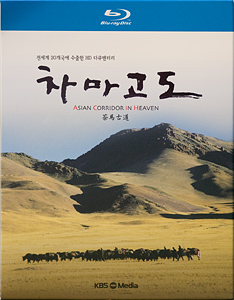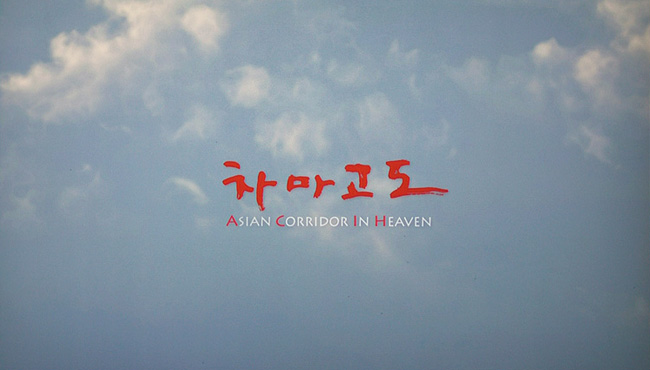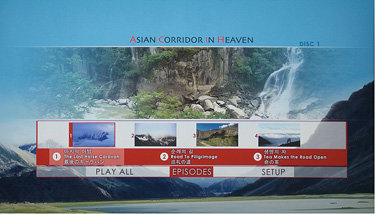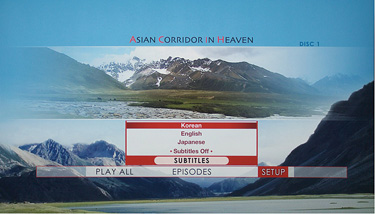Review by Leonard Norwitz
Studio:
Theatrical: KBS Television, Korea
Blu-ray: KBS Media
Disc:
Region: All
Runtime: 360 min
Chapters: 6 p
Size: 25 GB
Case: Standard Blu-ray case x 2 in slipcover
Release date: November 7, 2008
Video:
Aspect ratio: 1.78:1
Resolution: 1080i
Video codec: AVC @ 17 Mbps
Audio:
Korean Dolby Digital 2.0
Subtitles:
Korean, Japanese, English
Extras:
• none
The Film:
10
As I consider how to put my thoughts and feelings about this
video, I am suddenly taken with the idea of documentary as a
kind of high-tech zoo. Both permit a part of the population,
usually city- dwellers like ourselves who have access to the
means to watch these things, to peer into a world that they
are unlikely to have any contact with otherwise. In the
present case, the subject is ourselves, not so much as we,
who are watching this, are, but we who we once were: people
who actually live their traditions and beliefs, not simply
honor them a few of times a year on designated holidays.
Cutting right to the chase: despite its lack of extra
features, low bit rate, and absurdly high price, Chamagodo
is a must-have high-definition documentary that, once you
start watching, and especially on a large screen, it is
unlike anything you have ever seen. It is an experience akin
to the reading of Moby Dick or attending a performance of
Wagner's Ring. This is because the
cumulative experience is much more than the sum of its
parts, let alone a scene here or there, or the couple of
dozen screen captures contained in this review.
Throughout the series, I found myself pausing every 20 or 30
seconds to photograph this image or that in a vain effort to
capture the essence of what passed before my eyes - there
were that many of them. Human interest and historical
context aside, Chamagodo is relentlessly beautiful. Every
shot, every placement of the camera, every movement across
the frame is a work of art. The photography is effortless,
yet when you consider the locations, you can't help but
marvel at the impossibility of it all, let alone what the
participants themselves are about. I should mention that
various descriptions of the content of this series cites the
"Ancient Tea and Horse Caravan Road.” The word “road” in
this context should be taken advisedly, for these remote
trails are often only one meter wide and not meant for
anyone with a fear of heights or open spaces.
Chamagodo is the product of subtle teamwork. In each
segment, the journey pauses for a moment as the traders,
trekkers, workers and pilgrims speak to us (not to some
unseen interviewer to camera left or right, as is usually
the case these days). They share with us their feelings and
expectations about their unusual journey – unusual for us
civilized urbanites – their calling, if you will. Why do
they continue to do this, generation after generation, for
hundreds of years? Why do these women bend, load and carry
20 Kg of water, hour after hour, day after day? Why do these
men make a seven-month 1500-mile pilgrimage over every
imaginable terrain, stopping every five paces to fully
prostrate themselves in a momentary prayer. How could it
have come to pass that tea grown in China would have been
packed across 14,000 ft passes to Tibet 200 years before the
Han Dynasty merely in exchange for horses? How did anyone
come up with the idea, let alone how could it have become a
driving life force for two millennia? And why would a
70-year old 500 gram packet sell for $100,00 today. How did
these trails, many hundreds of years old, some parts of
which are cut right out of the mountainside, come to be?
Watching these people, not for a few seconds or minutes as
with other documentaries, but for an hour at a time, is a
redirecting meditative experience.
As with Moby Dick and The Ring there are side trips. We
break off from the main path to join other groups on similar
paths, only to return. We are invited to a tent as a storm
rages outside, or to prayers by Tibetan Buddhist monks, or
to a local public health clinic to examine one of our
elderly pilgrims who began his trek with a life-threatening
illness. We visit Mt. Kailash, sacred to Buddhists and
Hindus alike, and Lake Manasarowar, said to be the origin of
the Indus and the Ganges and where all sins are cleansed,
and seek out the myth of Shambhala and the "Palace of the
Moon." The left brain is on hold as these journeys seem to
float past our eyes. Narrative connections are made almost
as an aside, and yet our guide seems to know all.
The camera serves as a window onto a world touched by
civilization only at the fringes - perhaps the most
extraordinary of which is the sight of giant trucks giving
way to a handful of pilgrims, walking and prostrating
themselves on the highway. The camera’s all encompassing
depth of field seems to be set for 6 inches to infinity,
while the microphone picks up everything from the sound of
the wind, to the rushing river below, to the breath of the
horses. Do not be surprised if you begin to think you can
hear the ice as it watches the travelers pass by. It's all
very zen-like and mind-altering. Yet all we are doing is
picking tea leaves, or harvesting salt, or bathing in a
lake, or pulling trapped horses out of swamp, or praying, or
hunting whales, or daring the gods. Somehow each of these
stories becomes an adventure. I'm not entirely sure how.
Episode 1. The Last Horse Caravan
Episode 2. Road to Pilgrimage
Episode 3. Tea Makes the Road Open
Episode 4. The Salt in Yanjing
Episode 5. Himalayan Salt Trek
Episode 6. Guge. Mystery of the Lost Kingdom
Official Site is
HERE and a few quick video snips can be viewed
HERE.
Image:
9/10
The first number indicates a relative level of excellence
compared to other Blu-ray video discs on a ten-point scale.
The second number places this image along the full range of
DVD and Blu-ray discs.
Despite the transfer employs relatively low bit rates
and is 1080i to boot, the image is jaw-droppingly beautiful.
It’s hard to take our eyes off it. Not every scene is
without technical issues: much of the pilgrimage is less
than perfect: it suffers from occasional fringing and is not
nearly as sharp as the other episodes, and some footage from
the Myths of the Guge is of historical vintage. In the long
distant master shots of hillsides, we can make out that
familiar dithering as the image tries to make sense of
itself. We may need to squint to see it, but it is there.
Perhaps because I know the bit rate is so low that I sense a
faint lack of density. I’ve had guests who are simply bowled
over by the image and do not comment on anything lacking.
Because it is shot on location and in HD video, contrast is
high and latitude is almost non-existent. I can’t image any
other part of the world that would tax the limits of the
medium so. On occasion, there are areas of the frame that
are completely blown out from uncontrollable overexposure.
Yet – and this is the thing here – the image is so direct
and unmanipulated that its magic comes through effortlessly:
we are transported to another time and place as if we are
there. I mean it – really. It’s like a window has just
opened into another world by way of a direct feed from the
camera. Planet Earth never looks like this. In its best
moments, Wild China doesn’t come close. Much of the time,
the image here is so good, the skies so pure and noiseless,
that we can’t help but wonder what it would have looked like
at bit rates of 40.
And there’s still more to admire: Movies shot on HD-video
have an advantage for those of use who still employ 30 fps
displays, such as my otherwise satisfying JVC D-ILA RS10.
There is virtually no motion distress because, unlike motion
pictures shot at 24 fps that require pulldown to work out
the discrepancy, the frame rate for HD-video is the same: 30
fps. As creatures walk across the frame, even during a pan
in another direction, there is no hint of blur. This is a
relief of unspeakable proportions!
Audio & Music:
8/7
That sense of immediacy we experience with the picture, we
experience with the audio – this without the help of an
uncompressed surround track. There seems to be no
"enhancing" post-processing, no attempt to rationalize the
different acoustic environments. And again, the nagging
complaint: how much more convincingly we could feel the
ground beneath our feet, touch the wind, the snow and the
stream if we could hear it as keenly as we know would have
been the case in a PCM or other uncompressed mix.
Choi Bul-Am's warm and inviting narration is always rendered
clearly, even hypnotically. There are extended sections
where he does not speak, and when he returns we are not
jolted into a left-brained consciousness (unless you read
the subtitles) but engaged like another instrument of the
soundtrack. While there is a main theme for the series, most
of the music departs from this and supports in an
ever-varying, self-effacing manner the visuals and drama
unfolding before us.
Operations:
3
This Blu-ray set is a pin-up for bare bones editions. In
addition to its having no extra features, there are no
episode summaries in any language in the video content and
none in an insert on the Korean edition. Curiously, the
Japanese edition includes a 4-page “:booklet” that describes
the series – in Japanese. The menu design is simple enough.
Each episode is marked in Korean and English, but the
non-expanding chapter thumbnails are not. The subtitles are
clear. There are only a few places where I didn’t
immediately understand the intent of the translation. It has
its share of clumsy, if literal, usages (e.g. “traders”
would have worked better than "stablemen".)
Finally, a word about the box design – or rather the lack of
one: It was Korea's attention to DVD packaging that won me
over several years ago. The packaging and art work for their
Special Editions, like The King and the Clown or Wonderful
Days, or for their home grown television series, like Damo,
are worthy of pride – for them and for me as a collector.
None of this attitude has been assumed for Korea's Blu-rays
– not for their movies or for this expensive television
documentary. The slipcase, made of an easily crushable thick
paper, houses two regular Blu-ray cases. That's it. Except
for the box cover and disc face art, the Japanese and
Korean editions are identical in this respect.
I wish there was a way to show our dissatisfaction with
Korea's approach to high definition video. Of the seven
Korean-produced Blu-ray titles listed at YesAsia (The Host
coming from Magnolia and very much the exception) all are
done on the cheap: they are either 1080i, when 1080p is the
standard, and at low bit rates so that they can make do with
single-layered capacities. Unfortunately, as of this
writing, there are no alternatives. I had hopes that the
Japanese edition of Chamagodo would remedy one or more my
misgivings about the KBS edition but, alas, it is identical,
except for the writing on the box and the fact that the
discs are "pressed in Russia" – a fact that seems to change
nothing.
For those living in North America, I advise picking up the
Korean edition through Hanbooks in Los Angeles
HERE. In other
areas, it’s a toss-up between YesAsia for the Korean edition
or Amazon/Japan
HERE for the Japanese.
Extras:
0
Even more than Planet Earth, we miss a making-of
documentary. How this project came to be, how Korea and
China got together on this, especially for filming in Tibet
and, most of all, how the several teams obtained the footage
they did and what challenges were presented in the doing of
it, are questions that will have to remain a mystery –
unless and until a follow-up documentary is offered. But
don't hold your breath.
Bottom line:
9
Chamagodo is a fascinating, hypnotic 6-part
documentary shot where no high-tech video production team
has successfully gone before. The audio is straight-up DD
2.0, yet clear and unfussy. Planet Earth may be the king of
flora & non-human fauna documentaries, but Chamagodo must
now be the new benchmark where we are the subject. Unlike
Fox’s recent documentary, Home, Asian Corridor in Heaven
respects its audience and assumes we don’t have to be
scolded or hit over the head to make its point. Very much
the contrary.
Leonard Norwitz
June 27th, 2009
![]()
![]()

![]()
![]()
![]()
![]()

![]()
![]()


.jpg)
.jpg)
.jpg)

.jpg)


.jpg)























